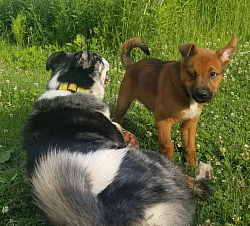Puppy Corner
Puppy Power!
This page is just for puppies! Check out our articles below to get a head-start on your puppy's journey!
Is a Puppy the Right Choice?
Choosing between a puppy and an adult dog is an important decision that depends on your family’s lifestyle, experience, and ability to meet the needs of the dog at different life stages.
When deciding between bringing home a puppy or an adult dog, it’s essential to weigh the unique challenges and rewards of each option carefully. Puppies are a blank slate and offer the opportunity to mold their behavior and habits from the beginning, which can be very rewarding. However, they require an intensive time commitment for training, socialization, and housebreaking, and their personalities are far from fully formed. Puppies reach sexual maturity around 1.5 to 2 years of age, a milestone that often brings significant behavioral shifts. Even the most obedient and friendly puppies can start testing boundaries or displaying territorial or hormonal-driven behaviors during this time, requiring consistent and patient training to help them transition into stable adulthood. Families considering a puppy should be prepared for training and possible unruly behaviors to last through this developmental phase, and be prepared for those demands.
On the other hand, adult dogs provide more predictability in terms of personality, energy level, and behavior, as they’ve already gone through these developmental stages. This can make them an excellent choice for families looking for a dog with established traits that align with their lifestyle. Adult dogs may come with some pre-existing training or, in some cases, behavioral challenges to work through, but they are often more settled and may require less time-intensive care than a young puppy. Additionally, for families who cannot commit to the rigorous training and attention puppies demand, an adult dog can provide a smoother adjustment into the household. Ultimately, the decision should focus on what suits your family’s schedule, resources, and ability to address the unique needs of either life stage while ensuring a lifelong commitment to the dog’s care and well-being.
Building Blocks to Success; Learning Lifelong Foundations
Setting a puppy up for success from the start is one of the most effective ways to ensure a lifetime of positive behavior and a harmonious relationship between dog and owner. While it might seem overly strict or even unfair to place boundaries on a young puppy, or to ask them to learn focus before engaging in fun activities, this approach is actually crucial for fostering a well-mannered adult dog. Puppies are constantly learning, whether their owners are actively teaching them or not. If left to their own devices, they will naturally adopt behaviors that serve their own interests, such as chewing furniture, jumping on guests, or ignoring commands, simply because they were never taught differently. These habits, once established, are much harder to undo later and often leave lasting imprints on the dog’s behavior, even with extensive retraining.
By introducing boundaries, focusing on building impulse control, and reinforcing good habits early, you prevent negative behaviors from taking root. For example, teaching a puppy that calm behavior earns rewards or that chewing appropriate toys is fun ensures that they naturally gravitate toward these behaviors as they grow. Puppies who learn from the start that “bad” behaviors do not yield rewards are less likely to test boundaries later in life. This proactive approach to training also prevents the cycle of frustration for owners, who might otherwise spend years trying to undo ingrained habits. Dogs raised with consistent boundaries and training tend to mature into balanced adults who rarely feel the need to push limits, as they’ve never been rewarded for doing so.
Ultimately, teaching a puppy how to navigate the world in a structured and rewarding way sets them up for lifelong success. Allowing complete free reign during the formative months often leads to behavioral issues that require far more effort to manage later. Establishing a foundation of good habits from the start is not only a gift to the owner but also to the dog, who benefits from clear communication, reduced stress, and a stronger bond with their human companions.
Socialization; Basic Principles and Common Misconceptions
Socialization is a critical process in a puppy's early life that helps them develop into well-adjusted, confident adult dogs. It refers to the gradual introduction of a puppy to various people, animals, environments, and experiences, aiming to build positive associations and comfort in a variety of situations. The goal of socialization is not just to expose puppies to different stimuli, but to teach them how to respond appropriately to these experiences, ensuring they grow up to be well-behaved and emotionally stable. Effective socialization is an ongoing process that continues throughout a puppy's first year, with particular emphasis on the first 16 weeks, which are considered the most crucial developmental period for socialization. A well-socialized puppy is more likely to be comfortable in new situations, less likely to develop behavioral issues, and better equipped to handle the challenges of living in a human-centered world.
Misconceptions about puppy socialization often arise from the belief that exposing a puppy to as many environments, people, and dogs as possible is the key to good socialization. For example, many people think that taking their puppy to a crowded farmers market or a busy dog park will automatically ensure it becomes well-rounded and friendly. However, these types of situations can overwhelm a young puppy, particularly if they are exposed to them before they are developmentally ready, or without proper guidance. In reality, socialization isn't just about exposure; it’s about controlled exposure in which the puppy learns to handle these new experiences with a focus on their handler. For instance, a puppy at a farmers market may become overwhelmed by the noise, crowds, and unfamiliar smells, leading to fear-based reactions like retreating or barking. At a dog park, puppies might encounter unrestrained, exuberant dogs, which could cause anxiety or even aggression later in life. These experiences are often mistakenly thought of as "socialization," when they are really stress-inducing events for the puppy that can potentially lead to negative associations.
The focus of positive puppy socialization should be on introducing the puppy to new experiences, but at a pace that allows the dog to feel comfortable and confident. Importantly, the puppy should also be learning how to focus on their owner during these exposures, which helps the puppy learn that their human is the source of safety and guidance, no matter what else is happening around them. It’s crucial to balance socialization with clear communication between the dog and handler, rather than just letting the puppy "experience everything." Puppies are most successful when given structured experiences where they can observe, explore, and interact in a manageable way, so they don't become overwhelmed.
Furthermore, a helpful guideline for socialization is the “5-minute rule,” which recommends limiting any socialization or overstimulating experience to 5 minutes per month of age. For example, a 3-month-old puppy should not be exposed to high-stress situations for more than 15 minutes. If multiple exposures are necessary, they should be spaced apart with sufficient downtime in a calm, safe environment to allow the puppy to reset. Overloading a puppy’s sensory system before their social and developmental foundations are laid can cause long-term behavioral issues. Setting up socialization sessions in this thoughtful and deliberate way ensures puppies grow into confident, adaptable, and well-behaved adult dogs.
This careful, positive approach to socialization prevents the common mistake of pushing puppies too hard, too fast, or expecting them to learn to "get along" with all dogs or handle every situation on their own. When done properly, the goal is to build positive associations with the world around them while strengthening the bond between puppy and owner.
Additionally, even when everything is done "right" in terms of socialization, it’s important to remember that some dogs may still develop problem behaviors. This can be due to a range of factors including genetic predisposition, specific traits of the breed, health issues, or pain-related concerns that are not immediately apparent. While proper socialization can help minimize these risks, it doesn’t guarantee that a dog won’t encounter challenges as they grow and develop. It’s also important to recognize that some dogs might naturally be more sensitive or reactive than others, regardless of how well they were socialized. This does not make them "bad" dogs, nor does it mean that socialization should be disregarded. It simply highlights that, like any living being, dogs can have their own unique set of needs and challenges that may arise unexpectedly. What’s most important is to approach these situations with patience, understanding, and a willingness to adapt training and care as needed.
Planning for your New Best Friend; Puppy Checklist
New Puppy Essentials Checklist
Below is a short list of things to consider and have in place before bringing home a brand new puppy!
Clicker – For effective training. More on Clicker Training can be found on our Behavior Zone page.
Treat Pouch – To carry training treats conveniently during sessions or walks.
Training Treats – High-value, soft treats for reward-based training. These should be different than your every day treat; they should be small, easy to eat quickly, and very high value like fresh cooked meat or freeze dried food.
Long Line – A 20-30 foot leash for safe distance training and recall practice. We do not advocate against Flexi-Leashes, however we do not recommend using them without first consulting a professional due to the high risk of misuse and potential injury from misuse.
Regular Leash – A sturdy 4-6 foot leash for everyday walks.
Collar and Harness – A harness for comfort and control, and a collar for holding identification tags and other information.
Durable Chew Toys – Examples include KONGs, Collagen based chews (No Rawhide!), or interactive long-lasting chews like Starmark's Everlasting Treat.
Puzzle Toys – These are great for much needed mental stimulation. Some examples of these are Nina Ottoson brand puzzles, or toys like snuffle mats. For a more in depth coverage of puzzle toys, please see our article on Beating Canine Boredom, located on the Behavior Zone page. Especially with young dogs and puppies, we recommend feeding your dog almost exclusively from puzzle toys and feeders in order to provide adequate mental stimulation.
Baby Gates or Exercise Pens – To section off areas and prevent accidents or chewing. These are one of the most important but easily overlooked tools one can use when managing a new puppy.
Crate – For crate training, with proper sizing for comfort and safety.
Potty Pads – For house training, especially for indoor or apartment living.
Enzyme Cleaner – To thoroughly clean up accidents and prevent marking behavior.
Comfortable Bed – Puppy-sized for security, washable for cleanliness.
Food and Water Bowls – Stainless steel or ceramic, as they are more hygienic.
Puppy Food – High-quality, veterinarian-recommended.
Grooming Supplies – Nail clippers, brush, shampoo formulated for puppies.
Adequate funds for First round of shots, Heartworm Protection, Flea and Tick Protection, ID Tag and Microchip – Include your contact info for emergencies.
Vet-Recommended Dental Care – Puppy-safe toothbrush and toothpaste.
First Aid Kit – Tailored for pets, with bandages, antiseptic, and a guide.
See Below for Information on our Puppy Classes and Puppy Board and Train!



